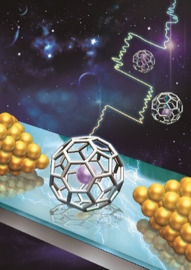What are the limitations of our current technology? With current integrated circuit technology, the fundamental limit is the heat dissipated as transistors switch; there is a limit to the number of transistors one can pack onto a chip without melting the chip. One device with the potential to dissipate less energy is the single molecule electret.
Along with collaborators, Mark Reed, Yale professor of electrical engineering and applied physics, explored the single molecule electret, which is a carbon-82 cage-like structure with a gadolinium atom inside it. By applying an electric field to the structure and positioning the gadolinium atom in different parts inside the cage, the atom can interact with the cage and cause a polarization that persists after the electric field is removed.
“We found that that polarization [of the device] could be switched,” Reed said. “It doesn’t go on and off, but it changes the direction of the polarization, changing the way the current flows through the device.” The single molecule electret acts as a piece of memory, with one polarization representing a digital 0 in binary computing language and another representing 1. Additionally, a single molecule electret dissipates less heat than a single transistor, and the size of these electrets are on the nanoscale, allowing for creation of smaller, more stable electronics. However, producing these devices is hard; currently, making the electret only works once out of every fifty tries.
Nonetheless, the ability to create these single molecule electrets is amazing in itself. “It’s important to first understand the physics of what’s going on, try to explain that, and then hopefully we’ll find a way to fabricate [more advanced technology],” Reed said.

